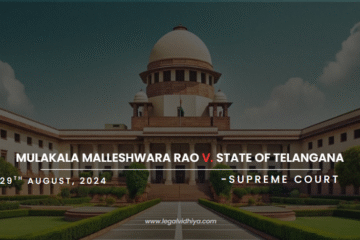| Citation | 2023 Latest Caselaw 584 SC |
| Date of Judgment | 25 July, 2023 |
| Court | Supreme Court of India |
| Case Number | Civil Appeal No. 4656-4657 of 2023 |
| Application | Vinod Kumar Sachdeva & ors. |
| Respondent | Ashok Sachdeva & ors. |
| Bench | CJI Mr. Dhananjaya Yashwant Chandrachud, Justice J.B. Pardiwala, Justice Manoj Misra |
| Referred | Article 227 of the Constitution, Section 8 of Arbitration and Conciliation Act, 1996. |
FACTS OF THE CASE
The defendant and the appellant, who are brothers, were working together as partners. They signed a memorandum of understanding ( MoU) with an arbitration clause addressing the sale of shared family homes to settle business debts. The appellant thereafter brought two legal actions seeking a long-term restraining order against the first respondent and a business called “ SACHDEVA & SONS INDUSTRIES Pvt. Ltd.” To refer both the dispute to arbitration, the first respondent filed a petition under Section 8 of The Arbitration and Conciliation Act, 1996. Although the trial court had rejected the application, the High Court upheld them and ordered that the controversies be presented. To meditate. On appeal, the case reached the Supreme Court.
ISSUES
- Whether disputes between the parties be referred to the arbitration under the arbitration agreement in the MoU?
- Whether parties who were not signatories to the MoU be forced to arbitrate under the agreement?
ARGUMENTS
Only the appellant and the respondent signed the memorandum of understanding and arbitration agreement. According to the appellant the first respondent and the appellant were the sole parties to the MoU and its arbitration clause. Because they were the only parties to the arbitration agreement, the appellant and the respondent should be bound by its provision and responsibilities.
The corporation and the bank, two parties that wanted to be bound by arbitration, were not signatories to the MoU. The appellant claimed that organizations such as “ SACHDEVA & SONS INDUSTRIES PRIVATE LIMITED” and “CANARA BANK”, which wanted to be bound by arbitration, were not signatories to the MoU. Therefore, as a result, these non-signatory entities cannot be forced to arbitrate disputes under the terms of the agreement.
Shareholders in the enterprises who were not family members were not signatories. The appellant argued that the non-family shareholders in the companies named in the MoU were not parties to the arbitration agreement. As a result as per the agreement which was signed only by the appellant and the respondent, te y could not be referred to arbitration.
On the basis of the inclusion of the arbitration agreement in the MoU, the first respondent argued for reference to the arbitration under Section 8 of the Arbitration and Concillation Act, 1996. The first respondent made out the case that the argument should be made in the context of Arbitration and Concillation Act, 1996. Disagreements raised in lawsuits should be used to refer to arbitration. The first respondent’s argument probably centered on the existence of an arbitration clause in the MoU, which required that any issues arising from the agreement be resolved by arbitration.
The defendant argued that arbitration should be used to settle the suit claims as they fall within the terms of the arbitration agreement. The defendant claimed that the arbitration clause in the MoU applied to the matters addressed in the suits. The respondents insisted that, as per the disagreement should be resolved exclusively through arbitration.
The defendant by stating these points aimed to prove that the claims made in the suits were subject to arbitration as per the arbitration clause in the MoU. He argued that instead of deciding the disagreement in the court, the court should refer the dispute to the arbitration as per section 8 of the Arbitration and Concillation Act, 1996.
JUDGEMENT
The arbitration clause in the MoU was scrutinized by the Supreme Court. It was noted that the parties intended to be bound by arbitration and were not signatories to the agreement, and the MoU was signed only by the Appellant and the First Respondent. Non-family shareholders in the companies were also not signatories to the arbitration agreement.
The Supreme Court overturned the High Court decision and dismissed the Section 8 applications submitted by the first defendant. In its analysis the Supreme Court carefully considered the arguments made by both the parties as well as the language of the MOU which contained the arbitration clause. The MOU was signed only by the Appellant and the First Respondent, and the arbitration agreement was only applicable to disagreements between these two parties, the Court held.
The court further explained that the arbitration agreement did not apply on non-family shares in the companies that were not included in the original MoU. Under the term of the agreement he could not be forced to arbitrate disputes because he had not signed it. Based on these findings, the Supreme Court ruled that the High Court’s order referring to arbitration under Section 8 of the Arbitration and Conciliation Act, 1996 was wrong. In this case it was not appropriate for the High Court to use section 8 to refer disagreements to arbitration because the parties seeking to be bound by arbitration were not signatories to the arbitration agreement.
REFERENCES
https://www.lawyersclubindia.com
This Case analysis is written by Bhaavya Mishra of Vikramajit Singh Sanatan Dharma College, Intern at Legal Vidhiya.




0 Comments